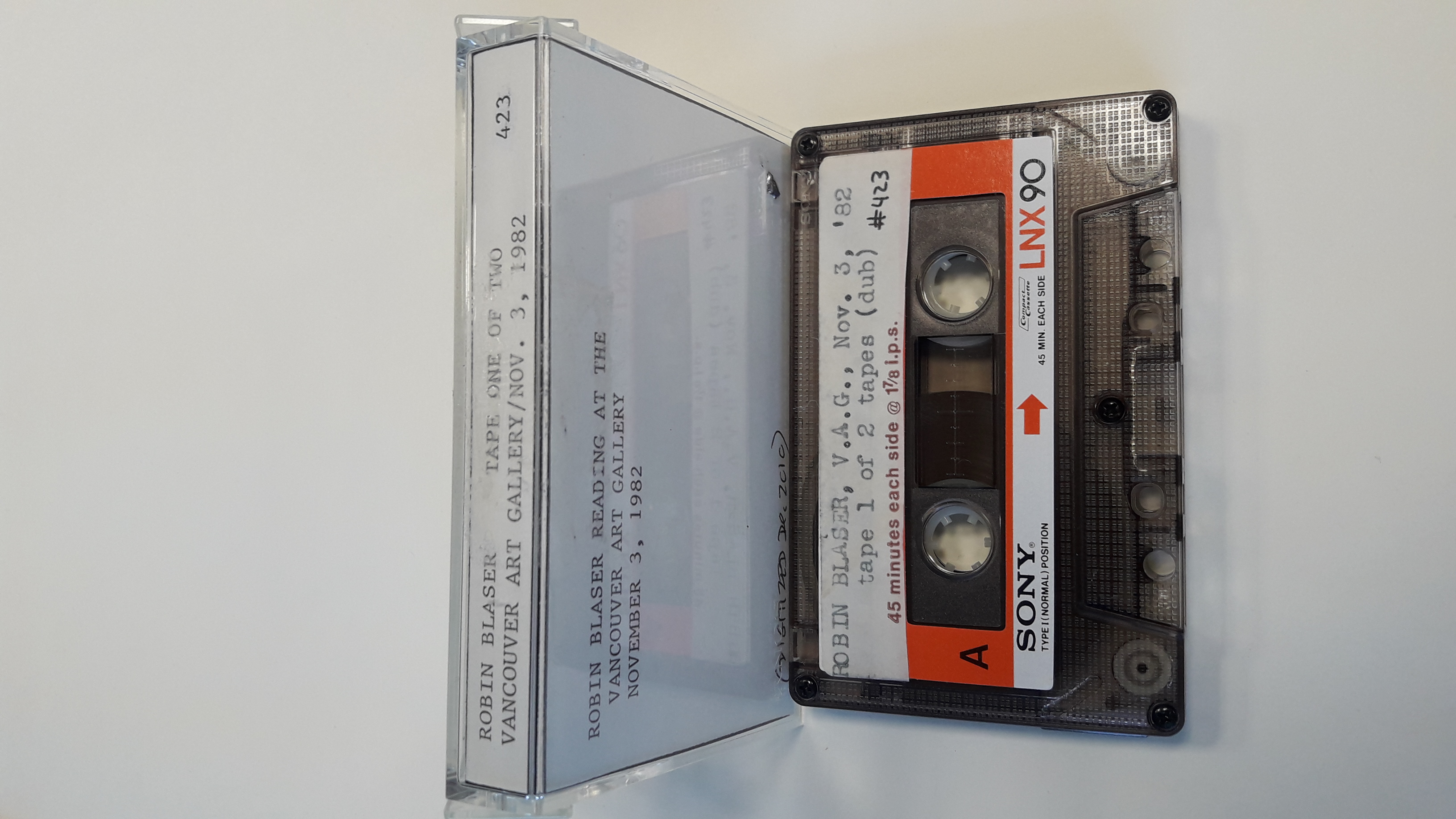CLASSIFICATION
Swallow ID:
5706
Partner Institution:
Simon Fraser University
Source Collection Title:
Reading in BC Collection
Source Collection ID:
MsC 199
Source Collection Description:
Reading in BC collection was assembled during the late 1970s and ‘80s. There are approximately 1000 tapes in this collection. It consists of the recordings of Canadian and American writers, mostly poets, reading poems, talking, being interviewed, participating in panel discussions, and so on. Most of the recordings were made in BC, but there are some made elsewhere in Canada or the USA. Quite a few of these recordings are unique copies, not to be found elsewhere.
Source Collection Contributing Unit:
SFU Library
ITEM DESCRIPTION
Title:
Robin Blaser reading at the Vancouver Art Gallery on November 3, 1982 part 1 of 2 #423
Title Source:
cassette and J-card
Title Note:
Liner notes: see the photo in material description
Language:
English
Production Context:
Documentary recording
Identifiers:
[RB_423]
Rights
Rights:
In Copyright (InC)
CREATORS
Name:
Blaser, Robin
Dates:
1925-2009
MATERIAL DESCRIPTION
Image:

Recording Type:
Analogue
AV Type:
Audio
Material Designation:
Cassette
Physical Composition:
Magnetic Tape
Extent:
1/8 inch
Track Configuration:
2 track
Playback Mode:
Stereo
Sound Quality:
Excellent
Physical Condition:
Good
Other Physical Description:
Black and white clear jewel case with J card
DIGITAL FILE DESCRIPTION
Channel Field:
Stereo
Sample Rate:
44.1 kHz
Duration:
T00:47:00
Size:
50.6 MB
Bitrate:
32 bit
Encoding:
WAV for master files and .MP3 for online files
Channel Field:
Stereo
Sample Rate:
44.1 kHz
Duration:
T00:46:58
Size:
50.2 MB
Bitrate:
32 bit
Encoding:
WAV for master files and .MP3 for online files
Dates
Date:
1982-11-03
Type:
Production Date
Source:
J-card
LOCATION
Address:
750, Hornby Street, Downtown, Vancouver, District of North Vancouver, Metro Vancouver Regional District, British Columbia, V6Z, Canada
Venue:
Vancouver Art Gallery
Latitude:
49.28287695
Longitude:
-123.1205638545168
CONTENT
Contents:
Side Track No. Comments
One 001 Blaser introduces “The Violets”; the translation of Whitehead into poetry
017 Preface to the paper: a “collage” of quotations
034 Quotation from John Russel’s The Meanings of Modern Art (“Art is there to make sense of the World…”)
046 Quotation from Philip Rieff from Triumph of the Therapeutic
060 Blaser reads an entry from his journal
102 Reads W.C. Williams’ “St. Francis Einstein of the Daffodils”
120 The specialized meanings of some terms used by Whitehead: “prehension”, “subjective aim”, actual entities”, “eternal object”, “feeling”, “God”
180 Begins to read “The Violets”
209 “The American poet who has made the most profound use of Whitehead’s thought is Charles Olson…” (Lines, p. 61)
248 “The reality of Marxism remains, as it began, The other face of Hegel…” (p. 62)
298 “What I have noticed in the poetry and poetics of the most important poets is that they are arguing, weaving, and composing a cosmology and an epistemological practice” (p. 62)
324 “I have arranged my essay to include copious quotation” (p. 64)
347 “In a letter of 1916, before the essay was printed in 1919, Pound states his interest” (p. 65)
385 “This wonderful voice, guiding science and, as we shall see, entering into poetry, draws attention to what is most to be attended to in art…”
430 “Among Olson’s books, now collected in The Charles Olson Archives…” (p. 67)
495 “This lecture was “preceded and followed” by study sessions on Process and Reality” (p. 68)
529 “This well-judged summary brings us a long way into a sense of Olson’s response to the philosopher…” (p.69)
558 “A fresh world-view, their indebted to science by way of Einstein and Whitehead…” (p. 70)
580 Side one ends in the middle of a quotation from W.C. Williams
Two 001 “Paul Christensen describes the look and feel of the poems in just such terms…” (p. 70)
010 “Olson’s direct use of Whitehead’s thought by way of reference, bottowing, and quotation can be traced to Process and Reality and to Adventures in Ideas” (p. 71)
050 “This move away from a systematic relationship to Whitehead’s philosophy of organism should be noted…” (p. 72)
080 “This lecture is marked by its introductory character from the initial statement on coming to know Whitehead’s thought…” (p. 73)
104 “From the passages quoted by Olson, Whitehead turns to a further consideration of the ‘second stage of feeling’… (p. 74)
136 “It is at such a point as this that we may begin to understand what I have called Olson’s translation of Whitehead” (p. 75)
170 “Olson consistently translates Whitehead’s philosophy of organism and its magnificent ‘vision’ of process back into his own acts as a poet of perception and intelligence” (p. 76)
206 “Olson terms the condition a ‘return to object’ and he returns art to the ‘contest’” (p. 77)
224 “The sudden appearance of ‘one’s self’ in this context may seem abrupt.” (p. 78)
261 “With many a quotation, I have endeavoured to dramatize the two languages of these men…” (p. 79)
288 “Two epigraphs open the argument…” (p.80)
332 “Olson is proposing to date the loss of the sense of reality as a process at that point” (p. 81)
370 “Olson draws a line from the underlined word ‘multiplicity’ to the bottom of the page…” (p. 82)
401 “This ‘WILL’ includes an obedience within the process…”’ (p. 83)
“Interpretation, with its lingering positivism and its confused urge towards materialism, too often ignores the fundamental religious temper of poetic thought” (p. 85)
516 “This is an important moment of preparation in von Hallberg’s argument…” (p. 86)
584 “From the underlined word ‘objects’, Olson draws a line to the bottom of the page…” (p. 87) – side two ends here
Notes:
SFU BC Readings formatting

